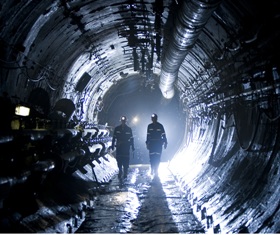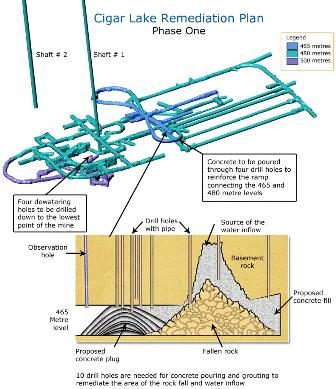 Cigar Lake is one of the world's most promising uranium deposits, with estimated reserves of 113 million pounds of U3O8 at grades as high as 20.7%. Led by Cameco, holding 50% of the project, a consortium of Areva Resources Canada (37%), Idemitsu Canada Resources (8%) and Tepco Resources (5%) has been developing the deposit in the north of Canada's province of Saskatchewan.
Cigar Lake is one of the world's most promising uranium deposits, with estimated reserves of 113 million pounds of U3O8 at grades as high as 20.7%. Led by Cameco, holding 50% of the project, a consortium of Areva Resources Canada (37%), Idemitsu Canada Resources (8%) and Tepco Resources (5%) has been developing the deposit in the north of Canada's province of Saskatchewan.In October 2006 a rockfall in the underground production area of the mine led to water ingress which was not stopped by the closure of bulkhead doors. When it became clear that the rate of water ingress far exceeded the speed that water could be removed by pumping, Cameco managers decided to evacuate the mine and allow the water to overtake it.
Cameco have said the first of five phases of remediation is underway and that the mine should begin operation in 2010, revised from an initial schedule that specified early 2008. Production levels from the mine will be unaffected at 18 million pounds U3O8 per year.
Besides the delay in operation, Cameco's share of remediation expenses is estimated at C$46 million ($39 million), of which at least C$5 million ($4.3 million) has already been spent. Extrapolating from the project split, the total cost of the setback can be put at C$92 million ($72 million), while the scope of the project has increased in terms of additional groundfreezing and pumping capacity. A technical report will be released in March detailing the impacts of these increases of scope on production costs, but Cameco said the mine would remain "an attractve low-cost producer," largely because of the very high grade of the ore.
Cameco warned, however, that further problems with water inflow would remain a possibility. The company described the difficulties with weak ground formations at Cigar Lake. The sandstone overlying basement rocks contains significant amounts of water at hydrostatic pressure. Freezing the ground is expected to increase rock stability, minimise the risk of inflows above unconformities as well as reduce radiation exposure from radon dissolved in the groundwater. However, Cameco noted that "freezing will only reduce, not eliminate, these challenges" and that "water inflows are generally not insurable."
Cigar Lake is still expected to produce 18 million pounds of U3O8 per year, reaching that level of output around 2013. Over the entire life of the mine, output should be around 7.5 million pounds of U3O8 per year.
| The remediation plan The first phase of remediation - already underway - involves drilling465 m down to the tunnels immediately downstream of the point water wasentering the complex. Several layers of concrete, designed to hardenunderwater, are being pumped into the tunnels to form a plug, whichwill be grouted by a further high-pressure pumping of cement. Then thearea of the rockfall itself will be filled with grout. Work continuesaround-the-clock to achieve this and Cameco has already secured all the equipment required.  The second phase would see water in the remainder of the complexremoved before the concrete plug could be verified and bulkhead doors,underground pumps and ventilation systems be repaired. Around the endof this year, Cameco expect to install additional ground freezingequipment to keep water entering the mine tunnels. The second phase would see water in the remainder of the complexremoved before the concrete plug could be verified and bulkhead doors,underground pumps and ventilation systems be repaired. Around the endof this year, Cameco expect to install additional ground freezingequipment to keep water entering the mine tunnels.The third phase would see any additional work identified during the second phase carried out. The fourth phase involves the completion of 'undergroundrehabilitation' such as the securing of areas to prevent ground fall orwater inflow, re-establishing ventilation, installing upgraded pumpingcapacity and re-establishing the ore-freezing program. Cameco scheduledthis work to be complete around the summer of 2008. The fifth and final phase would be the resumption of construction. Eachphase must be approved by the Canadian Nuclear Safety Commission andSaskatchewanian authorities. |
Further information
Cameco
WNN: Cameco remediate Cigar Lake delay




_18570.jpg)
_18938.jpg)
_33584.jpg)
_82983.jpg)





